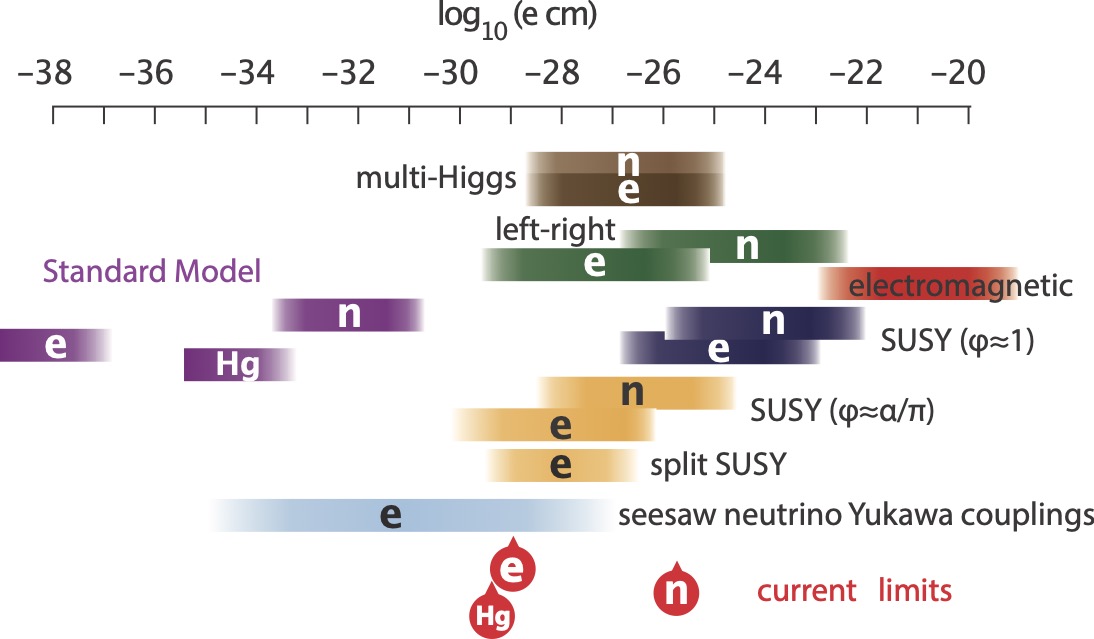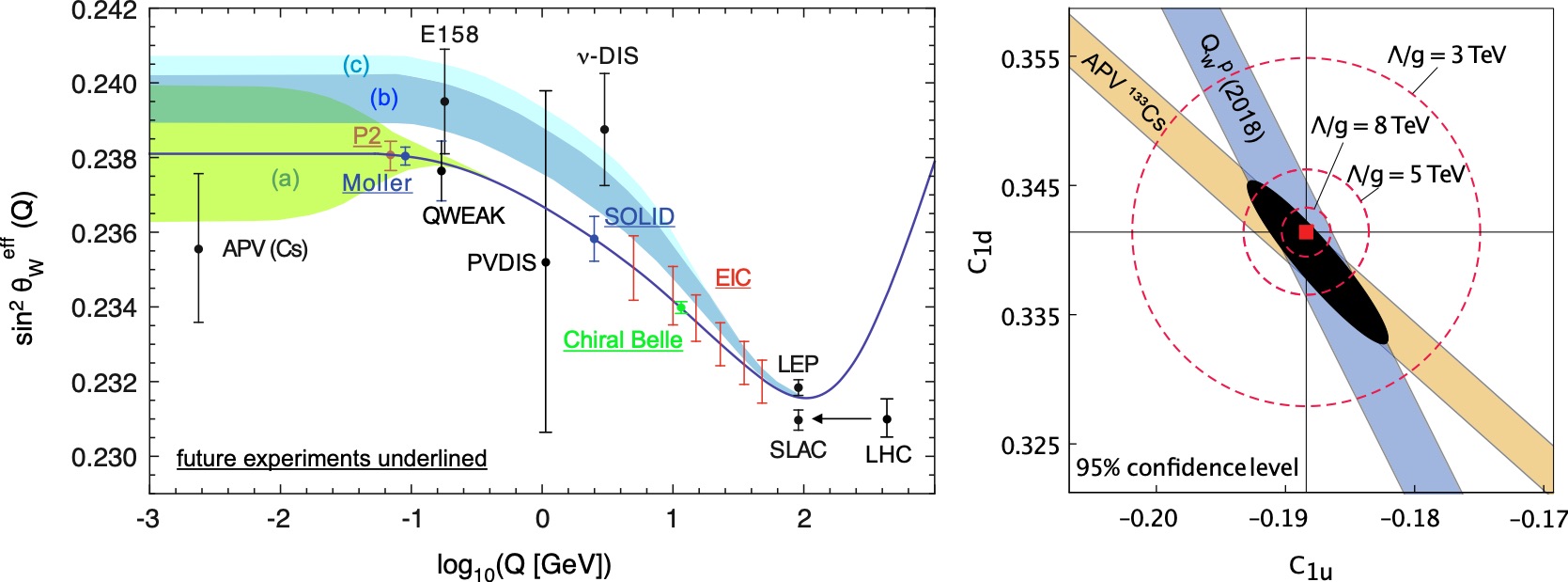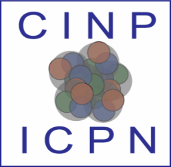Fundamental Symmetries Homepage
Welcome to the CINP Fundamental Symmetries Working Group
The Mission
The Scientific Working Group "Fundamental Symmetries" provides a forum for all Canadian scientists working on tests of the Standard Model at low and intermediate energies, primarily using the techniques of nuclear and atomic physics. It facilitates communication and collaboration within the community by organizing workshops and topical sessions at conferences and fosters the interaction with closely related communities in high energy, nuclear and atomic physics, astrophysics and cosmology. Outreach activities promoting our research are an important part of the working group's mission, both to the general public and to undergraduate and graduate students.
For more information about this working group, please contact us.
The Science
The Standard Model (SM) of Particle Physics is now half a century old, and in every way has been spectacularly successful. Its predictions have been confirmed over and over, as generations of increasingly sophisticated experiments in particle, nuclear, and atomic physics have pushed down the limits for possible deviations. At the "energy frontier'' of this endeavour, collider physics has not observed any new particles beyond the Higgs, which gave closure to the SM. Neither have we found signatures of physics beyond the SM with rare meson decays or permanent electric dipole moments in atoms, to just name two methods with exquisite reach. Yet, there are extraordinarily compelling reasons to believe that the SM should not be the final answer: It does not explain dark matter nor dark energy, it gives no satisfying explanation for the extreme matter-antimatter asymmetry that we observe in our universe, and it has withstood all efforts to integrate a quantum theory of gravity, so far. In addition, aspects of the SM, while reproducing observations correctly, seem contrived, indicating that we lack deeper understanding. Why are the masses what they are? Why 3 generations of quarks and leptons? Why is only the weak interaction violating parity, why is this violation maximal, and CP violation seems unnaturally small? In addition, we only start to unravel the details of the neutrino sector. Clearly, we must press on to find answers to these fundamental questions.
Nuclear physics, and closely associated experiments in atomic and molecular (AMO) physics, at the low-energy, precision, frontier, have played an important role all along in trying to answer these questions, complementary to high energy techniques. Advantages of this community are the diversity of efforts, nimble response to the changing landscape, relatively modest budgets, and diverse training of highly qualified personnel. Increasingly, a connection is forming to the emerging field of "quantum sensing'', or more broadly "quantum technology'', promising major gains in experimental sensitivity. Canada plays a distinguished role in the domain, with numerous efforts at two world-class domestic facilities, TRIUMF, and SNOLAB, as well as abroad, for example at JLab and CERN, covering most aspects of searches for physics beyond the SM.
Time reversal violation
The CP violation in the Standard Model is 10 orders of magnitude smaller than needed to generate the observed baryon asymmetry of the universe in the method outlined by Sakharov. The observation of a non-vanishing permanent electric dipole moment (EDM) in an atom, nucleus, or the neutron would directly violate time reversal symmetry (and also CP, assuming CPT symmetry holds), independent of any need for radiative corrections or theoretical interpretation. EDM searches are among the hottest topics for physics beyond the Standard Model worldwide and have made great progress over the years in ruling out theories beyond the SM.

Several Canadian groups are active in this field at the confluence of atomic, nuclear, and particle physics. Experiments are under development or in the planning stage at TRIUMF, exploiting a unique mix of capabilities: The cyclotron is the backbone of the high-density, ultra-cold neutron facility, enabling a TUCAN, a competitive search for a permanent electric dipole moment of the neutron. It is the driver for the actinium targets at ISAC, which produce record quantities of radioactive, heavy elements such as Rn, Fr, and Ra which are of particular interest for fundamental symmetries studies due to the large enhancement of T/CP (and also P) violating interactions. A possible search for an electron EDM in francium (FrEDM) and T-violating triple-correlation measurements with the atom trap facility TRINAT are under consideration using the world-leading radioactive neutral atom trap infrastructure at ISAC. ARIEL rounds out the synergies by enabling long, dedicated campaigns with actinide target beams. In addition, work is starting to harness the enhanced sensitivity of radioactive molecules for fundamental symmetries.
Neutral current weak interactions
The violation of parity symmetry provides for an extremely sensitive means to study the neutral current weak interaction, which is generally masked by the dominating electromagnetic processes. P-violating physics beyond the Standard Model at the TeV scale can be observed in low-energy experiments, keeping this field competitive in the LHC era. For example, when new states are discovered at the LHC, it will be important to know their couplings to the first generation of particles. Electrons and muons can be distinguished in the LHC detectors, but up/down quark jets cannot be separated from jets of other generations.
Low-energy experiments are in a unique position to assist with this question. There are three types of such “low-energy” weak neutral current measurements with complementary sensitivity.

Electron-electron scattering with MOLLER is measuring the electron's weak charge, electron-proton scattering (Qweak) determines the proton's weak charge and atomic parity violation (FrPNC) is predominantly sensitive to the neutron's weak charge. Different types of new physics contribute differently to each of them. For example, the atomic weak charge is relatively insensitive to one-loop order corrections from all SUSY particles; Moeller scattering is purely leptonic and has no sensitivity to leptoquarks. The Canadian community has had a long, prominent involvement in parity-violating scattering experiments and is playing a major role in the Qweak and MOLLER collaborations at Jefferson Lab. In addition, the FrPNC experiment aims to measure atomic parity violation in laser-trapped francium at TRIUMF, ultimately hoping to improve on the Cs result. The Canadian involvement in the PREX/CREX experiments nicely ties into this work by providing critical input to the francium experiment via the determination of nuclear neutron radii. The upcoming electron-ion collider EIC will provide important data in the region between low-energy experiments and the Z-pole.
Theoretical work on one-loop and two-loop electroweak radiative corrections of critical importance to the parity experiments is carried out by groups at Memorial and Manitoba.
CPT, Lorentz and weak equivalence principle violation
CPT invariance and Lorentz symmetry are at the very foundation of our current description of nature, as quantum field theories are firmly based upon these principles. However, in string theory and also in quantum gravity, which unifies the standard model of particle physics with general relativity in a ‘theory of everything’, CPT and Lorentz violation are frequently assumed. Furthermore, the weak equivalence principle - a fundamental assumption in Einstein’s general relativity - may be violated at a minute level in a fundamental theory. As low-energy experiments are, relatively speaking, not that much further away from the Planck scale as are colliders, the former play a very significant role in this field, driven by the extreme precision that can be reached mostly with laser and microwave-based measurement techniques. Canada is strongly involved in the high-profile endeavor of anti-hydrogen trapping and antimatter spectroscopy antimatter research, and it provides the largest contingent by country in the ALPHA collaboration working at CERN.
Nuclear decay spectroscopy
Precision measurements of the ft values for superallowed 0+ → 0+ Fermi beta decays provide demanding tests of the Standard Model. Such measurements have, for example, confirm the conserved vector current (CVC) hypothesis most stringently and set the strongest limits on fundamental weak scalar interactions, and, together with the Fermi coupling constant G_F from muon decay, provide the most precise determination of the V_ud element of the Cabibbo-Kobayashi-Maskawa (CKM) quark-mixing matrix. Recent theoretical developments have created significant tension for the unitarity of the CKM matrix. The Gamma ray spectroscopy group at TRIUMF is providing world-leading experiment results in this domain, as do Canadian theorists at Alberta and Manitoba.
Beta neutrino correlations with trapped atoms and ions, and cold neutrons
Particle traps are ideal tools for studying correlations in beta decay. The nuclear recoil escapes freely from the trap (i.e. there is no backing material), and its momentum and that of the beta can be measured, so the neutrino momentum can be determined. Furthermore, the nuclei can be spin-polarized by atomic optical pumping methods to an extremely high degree, and can be probed by atomic methods independent of the nuclear decay. Correlation experiments set stringent limits on potential scalar and tensor weak currents, and can also be used to constrain more exotic physics. Canada is a world leader in this line of research. The TRINAT facility at TRIUMF has pioneered the use of neutral atom traps to measure beta decay correlations. On the cold neutron side, two landmark measurements of parity violating asymmetries have seen their successful conclusion, nPDGamma and n3H3, while their successor Nab at Oak Ridge , a decay correlation experiment, is gearing up to run during the coming 5 year period. Canadians are also involved in implementing an improved measurement of the neutron lifetime, BL3.
Neutrinos
A major open question is the nature of neutrinos and how they influence the evolution of the universe. The discovery that neutrinos are not massless has been transformative in that a neutrino could have an astonishing property of being its own anti-particle. An extremely rare nuclear decay mode known as neutrinoless double beta decay offers the only viable experimental method to test for this possibility. The observation of this most exotic decay mode, for example by the upcoming nEXO neutrinoless double-beta decay experiment, would provide irrefutable evidence that neutrinos are their own anti-particle and correspondingly that the symmetry of lepton number conservation is violated. Its observation would also provide strong experimental guidance for theories that go beyond the Standard Model, yielding insights into the origin of the neutrino mass. The BeEST experiment will search for sterile, keV-mass, neutrinos.
Synergies with theory
Fundamental symmetry measurements critically depend on nuclear, atomic, and particle physics theory to extract the underlying physics from the data. As mentioned earlier in this section, groups at Memorial and Manitoba have been active in carrying out one-loop and two-loop electroweak radiative corrections crucial for parity violating electron scattering experiments. Alberta and Manitoba are also playing a leading role in CKM unitarity tests by advancing the state-of-the-art in radiative correction calculations for V_ud.
In addition, recent advances in ab initio nuclear structure calculations by theorists at TRIUMF are starting to have impact on fundamental symmetry work, such as neutrinoless double-beta decay, permanent electric dipole moment searches, atomic parity violation (anapole moments), and beta decay.
Current or planned efforts with Canadian involvement
The links below offer brief introductions our work. Similar information, put into the broader context, can be found in the documents for the 2022-2026 Canadian Subatomic Long Range Plan.
- ALPHA antimatter research
- BeEST: search for sterile keV neutrinos
- BL3 neutron lifetime measurement
- CKM unitarity tested by nuclear decay spectroscopy
- EIC: fundamental symmetries at the Electron-Ion Collider
- FrEDM: search for permanent electric dipole moment in laser trapped francium (in planning)
- FrPNC: Atomic parity violation in laser trapped francium
- MOLLER: parity violating electron scattering
- Nab: cold neutrons
- nEXO: neutrinoless double-beta decay
- Radioactive molecules for fundamental symmetries (in planning)
- TRINAT beta decay correlations with laser trapped atoms
- TUCAN: Search for a permanent electric dipole moment of the neutron
G. Gwinner, 2021
